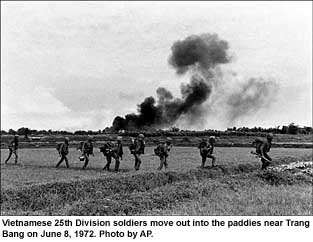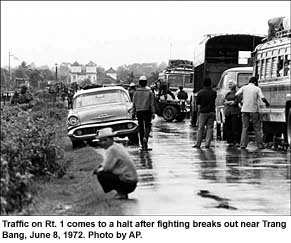|
THE BIGGER PICTURE
Nick Ut recalls
the Events of June 8, 1972
by Horst Fass and Marianne Fulton
 By
1972 most U.S. helicopter units had left Vietnam. It had become
more difficult for reporters to reach the isolated areas where South
Vietnamese troops, often surrounded by communist guerrillas and
regular north Vietnamese soldiers, were fighting. It was a time
when AP photographers had to travel the dangerous roads leading
out of Saigon, Danang or Pleiku towards areas where fighting took
place. By
1972 most U.S. helicopter units had left Vietnam. It had become
more difficult for reporters to reach the isolated areas where South
Vietnamese troops, often surrounded by communist guerrillas and
regular north Vietnamese soldiers, were fighting. It was a time
when AP photographers had to travel the dangerous roads leading
out of Saigon, Danang or Pleiku towards areas where fighting took
place.
At dawn of June 8, 1972, about 5 AM,
photographer Nick Ut loaded his camera gear, field survival kit,
flak-jacket and steel-helmet into one of the AP's Japanese made
minibuses (the AP correspondents called them 'command modules')
parked outside the Eden Building, where the AP's Saigon office was.
He wore a Vietnamese Marines style uniform with the nametags 'Bao
Chi' (for 'Press'), Nick Ut and Associated Press. He carried no
weapon. The vehicle had an assigned Vietnamese driver, who would
always stay with the car, while the photographer would usually wander
off with troops.
 Nick
travelled alone that day, without a correspondent. It had been reported
that traffic on Route-1 had been interdicted by North Vietnamese
troops - and it was Nick's assignment to reach the South Vietnamese
units that had been sent there to engage the enemy and re-open the
road. Nick asked the driver to head north - west, past Tan Son Nhut
airport and onto Route-1, which leads from Saigon towards the Cambodian
border. Nick
travelled alone that day, without a correspondent. It had been reported
that traffic on Route-1 had been interdicted by North Vietnamese
troops - and it was Nick's assignment to reach the South Vietnamese
units that had been sent there to engage the enemy and re-open the
road. Nick asked the driver to head north - west, past Tan Son Nhut
airport and onto Route-1, which leads from Saigon towards the Cambodian
border.
At the city limits both Nick and the
driver put on their flak-jackets: the open areas between villages
along Route-1 with their paddies and hedgerows were sniper territory.
Their vehicle soon mingled with buses and commercial vehicles which
also set out for travel at day break. During the night the roads
were unsafe and abandoned.
By 7:30 AM Nick Ut had reached the
outskirts of the village Trang Bang (about 25 miles WNW of Saigon)
and his driver joined a long queue of waiting vehicles: Less than
a mile away North Vietnamese troops still controlled a section of
Route 1 in Trang Bang. Soldiers of the Vietnamese 25th Division
had fanned out around the village and tried to sweep through it.
 "We
passed hundreds of refugees fleeing the village. They cooked and
slept outside the village, hoping to return when the fighting stopped.
It was the third day of fighting in the area." Ut later reported. "We
passed hundreds of refugees fleeing the village. They cooked and
slept outside the village, hoping to return when the fighting stopped.
It was the third day of fighting in the area." Ut later reported.
Nick left the car, introduced himself
to one of the battalion commanders and then joined the troops. There
were some firefights and casualties ensued. As the troops approached
the village across the paddy fields civilians emerged to flee towards
the South Vietnamese lines. Nick Ut was instantly at work, photographing
the soldiers, desperate refugees and early artillery and air-strike
support for the soldiers whose advance had stalled.
About noon the field commander of
the Vietnamese troops outside Trang Bang asked for additional air
support from South Vietnam Airforce units based at Bien Hoa, some
15 miles away. Nick made his way back to Route-1, waiting
like the soldiers, the travellers caught in their cars in the traffic
jam outside Trang Bang, and a flock of other reporters for the planes
to arrive and perform their bombing runs. A yellow smoke grenade
was thrown by a soldier marking the target area for the approaching
Skyraiders, Korean-war vintage planes. Trang Bang had fallen silent
- and the speculation was that the North Vietnamese and their Vietcong
allies had already withdrawn - a pattern familiar to experienced
observers of the war.
When the planes arrived overhead at
about 1:00 PM reporters and soldiers stood upright, watching. Nobody
at that time believed that even communist snipers were left behind.
The monsoon rain had stopped.
Nick met fellow reporters and friends
who like him frequently ran the dangerous roads to find battles:
There was David Burnett, from Time Magazine, Ut's Vietnamese photographer
friend Hoang Van Danh, a freelancer who would work for both United
Press International (UPI) and AP (he now lives in Switzerland) and
television teams from the BBC, ITN, NBC and other news organizations.
The rest is photographic history:
The two Skyraider aircraft of the VNAF bombed the edge of the village,
near the Cai Dai pagoda, in a familiar pattern - first explosive
bombs, then incendiary bombs - large containers with a mix of explosives,
white phosphorus and the black oily napalm - and ending up with
heavy machinegun fire during closing strafing runs. Then the planes
disappeared - nobody had heard any anti-aircraft fire. And
then the terrified, burned and wounded villagers came running from
the village, towards the line of soldiers and reporters standing
across the road.
Nick Ut recalled in a 1999 interview:
"When we (the reporters) moved closer to the village we saw the
first people running. I thought 'Oh my God' when I suddenly saw
a woman with her left leg badly burned by napalm. Then came a woman
carrying a baby, who died, then another woman carrying a small child
with it's skin coming off. When I took a picture of them I heard
a child screaming and saw that young girl who had pulled off all
her burning clothes. She yelled to her brother on her left. Just
before the napalm was dropped soldiers (of the South Vietnamese
Army) had yelled to the children to run but there wasn't enough
time."
Nick Ut used two cameras to photograph
the scenes in front of him - his Leica and a Nikon with a long lens.
Not far from him stood NBC cameraman
Le Phuc Dinh, who along with Ut is credited to have produced the
best documentation of Phan Thi Kim Phuc's desperate run down Route-1.
Le Phuc Dinh, who is shown at work in one of Nick Ut's pictures,
used a 16mm film and sound camera.
Both David Burnett and Hoang van Danh
changed film in their cameras during the peak moments of the action.
Danh managed a few pictures when Kim Phuc had reached the line of
photographers and soldiers and sold a few of them to UPI.
"Nicky, you got all the photos," said David Burnett.
Nick Ut recalls that Kim Phuc screamed
"Nong qua, nong qua" ("too hot, too hot") as he photographed her
running past him. When the girl had stopped Nick Ut and ITN correspondent
Christopher Wain poured water from their canteens over her burns.
Kim Phuc's relatives gathered around
her and the reporters. Nick Ut heard her saying to her also injured
older brother Phan Thanh Tam, "I think I am going to die." (Tam
is seen in Ut's award winning picture, running alongside her, at
left).
Kim Phuc's parents were still hiding
inside the Cao Dai pagoda.
Urged on by Kim Phuc's uncle, Nick
commandeered his car, and being one of the few reporters able to
communicate with the injured villagers he took over and carried
Kim Phuc into the car. Then other members of her family - her younger
brother Phan Thanh Phuoc (5), her older brother Tam (13), her uncle
and an aunt rushed into the car. Ut climbed aboard the now overcrowded
minibus last and ask the driver to speed towards the provincial
Vietnamese hospital in Cu Chi, halfway to Saigon. "I am thirsty,
I am thirsty, I need water" Kim Phuc continued to cry. When the
van moved Kim Phuc screamed out loud, obviously in great pain and
then lost consciousness. Nick, beside her, tried to console her
saying "don't worry, we will reach hospital very soon."
They reached the hospital within the
hour. The doctors and nurses there had seen and treated burn and
shrapnel wounds for many years. Even in situations when the hospital's
emergency wards were suddenly overcrowding with war injured an atmosphere
of quiet medical professionalism prevailed rather than panic and
confusion. Nick Ut knew very well that the doctors would attend
first those whose lives could most likely be saved, and put others,
who were expected to die, aside for later treatment. It was
a battlefield experience Nick Ut had often shared with soldiers
and civilians alike.
He pleaded with the doctors and nurses
to take care of Phan Thi Kim Phuc - and they did. Ut told them what
he had seen on Route-1, what he had photographed and that he expected
his pictures to be published everywhere.
Only when Kim Phuc was on the operating
table did Nick Ut leave the hospital and head towards Saigon, to
bring his film to the AP.
When a newsman later de-briefed Nick
Ut for a by-line story of what he had experienced on Route-1, Nick
did not mention that he helped Kim Phuc.
It was 28 years later, in London,
that Kim Phuc said in front of the Queen: "He saved my life."
|